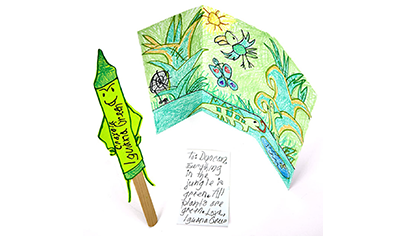Conversations With Crayons

Subject areas: Language Arts, Visual Art, Drama, Social-Emotional Learning
Time commitment: 60 – 90 minutes
Best for: Grades 3-5

Activity synopsis:
Students construct a crayon character stick puppet and write original dialogue to dramatize a story they create about a favorite crayon color after reading I’m Having a Blue Sky Day, by Maggie Testa, illustrated by Clair Rossiter. Integrate writing, drama, social-emotional, and visual arts with this color-filled project!
Materials list:
- Book: I’m Having a Blue Sky Day, by Maggie Testa, illustrated by Clair Rossiter, Simon and Schuster
- Blunt-Tip Scissors
- Colored Pencils
- Construction Paper
- Crayons
- Doodle Pad
- Index Cards
- Masking Tape
- Craft Sticks
- Washable Markers
Step-by-Step Instructions
RESPOND
- Discuss emotions. Everyone has a range of emotions. Naming them and saying how you feel is part of developing emotional health. Have children identify the emotion words they might use when they feel anger (fear, sadness, disgust, or disappointment). Prompt students to think of words for enjoyment (happiness, love, joy, pride, excitement, peace, or compassion) and sadness (worry, stress, loneliness, unhappiness, miserable). Invite them to make faces that show how moods change facial features. Eyebrows and mouths show a lot about how someone is feeling. Look at some drawn emojis or magazine faces to “read” emotions and give them names. Have children sketch a few faces with different emotions or moods by varying the mouths and eyebrows.
- Read the story, I’m Having a Blue Sky Day, by Maggie Testa, illustrated by Clair Rossiter. Have students notice the emotions that are shown and identified in the book. Review the illustrations once again looking for the shapes that make up the crayons (triangle top and rectangle body, arms and legs, hands and feet, curved and straight lines) and to notice the settings (sky, bridge, meadow, carnival ride, and so on). Have students discuss what they noticed, and what colors and features were interesting to them.
CREATE
- Create crayon puppets. Have children create their crayon puppets by drawing a triangle tip and a narrow rectangle body that may have straight or curved sides, adding arms, legs, hands, and feet. They should choose facial features that show emotions then cut out the puppets and tape them on sticks to create puppets. They may create two characters, each showing a different emotion, placed back-to-back on the stick. Students will name their crayon puppets, using color and emotion in the name, for example: Proud Purple Pamela or Surprised Silver Sam.
- In small groups, students will create stage settings for their puppet dialogues using paper and drawing tools such as crayons, colored pencils, and markers. These may be inspired by the book illustrations or may represent other settings of interest from your science or social studies curriculum.
PRESENT
- In their small groups, students will improvise (make up on the spot, listening to one another) short dialogues that focus on how their crayon puppets are feeling and why, how someone’s spirits can be lifted and how interacting with others gives them new ideas.
- Students will write dialogue or scripts that they want to expand upon, from the improv dramas. Their scripts can be written on index cards and shared with others who can modify and perform these written scripts.
- Provide time for the groups to perform the scripts and discuss the differences between improvisation and more formal dialogue. The crayon characters could introduce themselves by saying their names and how they felt about each type of performance.
Learn more
CONNECT with other idea extensions:
- Make a crayon comic strip for your characters by folding a 6” x 18” sheet of paper into a trifold of three scenes, for the beginning, middle, and end of a story idea. Pair students to make a collaborative strip so that one writes the beginning, one writes the end, and then they both write the middle together, with different crayon voices heard as writing skills, dialogue, and story development are explored.
- Have children delve deeper into the relationship between weather, color, and mood by creating and naming moody place pictures that the crayon characters can visit, such as Jenny’s Jolly Jungle and Maroon’s Moody Midnight.
- Crayola offers lessons, projects, webinars, and other art integration ideas at https://www.crayola.com/education



